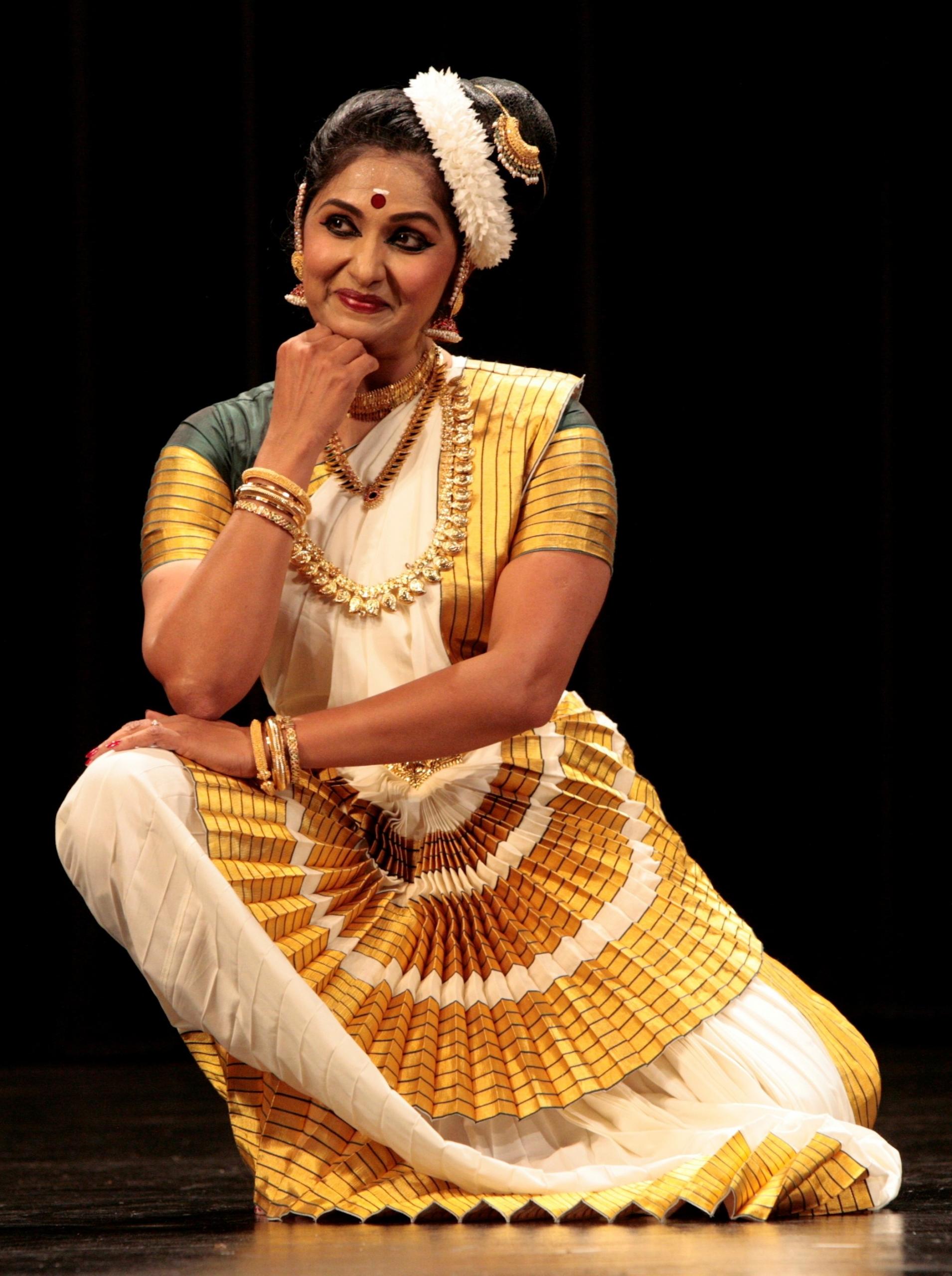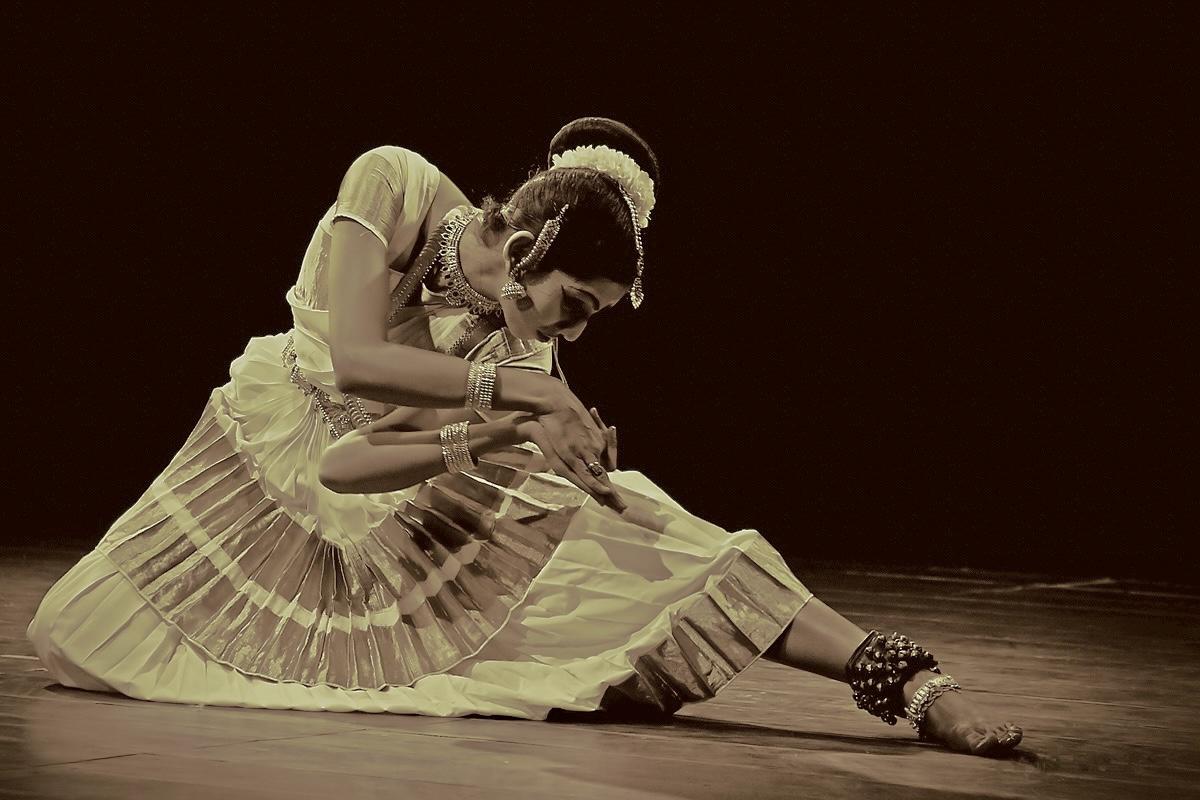One of Kerala's two most popular dance forms, together with Kathakali, Mohiniyattam is a classical Indian dance style that originated in the region. Though Mohiniattam's origins may be traced to the ancient Hindu Sanskrit scripture "Natya Shastra," which discusses performing arts, like other Indian classical dance styles, it follows the Lasya style, which emphasizes a more delicate, elegant, and feminine style of dancing. The word "Mohini," referring to Lord Vishnu's female form, is the source of the name Mohiniattam. Traditionally performed by female artists as a solo dance, it conveys a play through singing and dancing. The song is typically in Manipravala, a language that combines Sanskrit and Malayalam, and the recitation can be done by the dancer herself or by a vocalist performing Carnatic music.
One must first discover the Mohiniyattam dance's history in order to begin to comprehend it. The female incarnation of Vishnu, Mohini, is the first figure in the meaning of Mohiniyattam. The ultimate enchantress Mohini leverages her gender to her advantage in the struggle between good and evil. The verb moha, which means to bewilder or induce illusion, is the source of the word mohini. This ancient Indian dance form, which is still extensively performed today, has long represented the essence of feminine beauty and charm.

History of Mohiniyattam

Learn about the history of Bharatnatyam.
Lord Vishnu assumed the shape of Mohini in the Puranic epic Mahābhārata in order to entice and deceive Asuras, beings that rebelled against the gods. In numerous accounts, Lord Vishnu, also known as Mohini, uses her beauty and cunning to seduce and subjugate her adversaries. Bharata Muni's works are the source of Mohiniyattam. 200 BCE saw the completion of the Natya Shastra, the first comprehensive collection of writings outlining the Mohiniyattam dance.
The most fundamental components of the two traditional dance forms—Shiva's vivacious and intense Tandava dance and Parvati's soft, serene, and elegant Lasya dance—are explained in the book. Mohiniyattam more closely resembles the Natya Shastra text's description of the Lasya dance's structure and purpose. With Swati Tirunal's ascent to the throne in 1829 and her efforts to advance the fine arts in general, this dancing style was revived. Vadivelu created a suitable repertory during this period, which included the Chollukettu, which is an invocation that begins with a prayer to Shiva and ends with an offering to the goddess Bhagavati. This is when Mohiniyattam began to take shape. Due in part to a lack of royal sponsorship, Mohiniyattam entered another dark period after Swati Tirunal's rule came to an end.
Learn about the evolution of the Kathakali dance style.
Most of India's traditional dance traditions were derided as seductive during British rule in the 19th century, linking performers to prostitution, which contributed to the tradition's decline. By the 1800s, Vallathol Narayana Menon had established the Kerala Kalamandalam, the first art training institute, and had contributed to the lifting of the prohibition on temple dancing. The first official instructors of the Mohiniyattam dance were appointed by the institute to be Guru Krishna Panikker and Kalyani Amma.
The principles of medieval periods continue to inform modern Mohiniyattam, the classical dance form of Kerala, which features flowing, elegant motions devoid of sudden jerks or leaps. This is in line with Lasya's description of feminine motions as delicate and elegant. Mohiniyattam's contemporary instructions have purposefully omitted any motions that could be seen as vulgar or indecent. The book Balaramabharatam, penned by scholar and king Karthika Thirunal Bala Rama Varma, defines the entirety of Mohiniyattam today. The sixth and tenth chapters of the Natya Shastra are expanded upon in the Balaramabharatam.
Discover the story of the Odissi dance.
Repertoire of Mohiniyattam Dance Form
Mohiniyattam is distinguished by its elegant, flowing body motions that lack abrupt jerks or unexpected leaps. It is a part of the delicate, elegant, and feminine Lasya style. The glides and up-and-down motion on the toes, which mimic the sea's waves, the swinging of coconuts, palm palms, and paddy fields, highlight the movements. The footwork is rendered lightly and without terseness. Hand motions and mukhabhinaya with nuanced facial expressions are highly valued.
Find a teacher of Mohiniyattam with dance classes in Bangalore.
The Nangiar Koothu and the female folk dances Kaikottikali and Tiruvatirakali have been referenced in the movements. The focus of Mohiniyattam is acting. The dancer connects with the personality and emotions, found in pieces such as Padams and Pada Varnams, which provide a lot of room for expression on the face. The 24 hand movements are mostly taken from the literature Hastalakshana Deepika, which is followed by Kathakali. A few numbers are also taken from Balarambharatam, Abhinaya Darpana, and Natya Shastra. There are five basic postures, or mandalams, in the Mohiniyattam style:
- Samam: The practice of steady head and eyes with the body straight and legs together
- Kalamandalam: Slightly bent knees with feet placed precisely at two finger lengths apart; the prefix KAL means quarter, as in a quarter lower than SAMAM.
- Armandalam: The body lowers slightly more than the KALMANDALAM posture, with the knees coming into alignment with the thighs parallel to the floor. The prefix ARA means half.
- Mukamandalam: Lowering the body slightly, further still from the ARMANDALAM posture. The prefix MUKAL means three-quarters.
- Muzhamandalam: When the dancer sits down fully on her raised toes; the prefix MUZHU means full.
Learn about the origins of the Kathakali dance style.
The facial expressions and gestures are less theatrical and more realistic (lokadharmi) and natural (gramya) than rigidly conventional (natyadharmi). Classical pieces such as Chollukettu, Jatiswaram, Padavarnam, Padam, Tillana, and Slokam are part of the repertoire. In addition, Vallatol developed the popular pandattam and omanatinkal (lullaby), which are frequently performed at recitals. The majority of the pieces in the repertory were written by Swati Tirunal, who placed an emphasis on the literary substance, or Sahitya Bhava. These are conveyed by using suitable hand and facial gestures that incorporate all nine emotions.

Mohiniyattam Dance Costume
The dancer dons an off-white or white plain sari that is adorned with a matching choli or blouse and brightly coloured brocade that is intertwined with gold or golden threads around the edges. Embroidered from the waist up, the front portion of the sari is a pleated material with bands of concentric golden or saffron colours. The audience can view the artist's amazing footwork from a distance thanks to this decoration, which also enables her to perform it with flexibility.
Explore the myriad hues of Manipuri dance style.
A golden belt is fastened around the dancer's waist. Her hair, neck, ears, wrists, and fingers are all adorned with jewellery. Her ankles are covered in musical anklets, known as ghunghru, comprising leather straps with tiny copper bells attached. She has superb footwork while these create a rhythmic sound. Red-coloured natural dyes are applied to her feet and fingers to accentuate hand motions. The dancer often wears minimal makeup, with the exception of a tikka on her forehead. Her lips are brightly coloured red, and her eyes are accentuated to draw attention to their movements. Her hair is normally done in a tight round chignon on the left side of her head, adorned with flowers, usually jasmine, encircling the bun.
Learn how to dance through dance classes in Gurgaon and enjoy the traditional dance styles of India.
Famous Mohiniyttam Dancers
Sunanda Nair
One of the few people now actively practising Mohiniattam is Sunanda Nair, a renowned exponent of this traditional Indian dance form. Many believe her to be "the prime ballerina" among all Mohiniyattam dancers and one of the best young performers in India right now.
Immerse yourself in the wonderful history of Kuchipudi.
Kalyanikutty Amma
Kalamandalam Kalyanikutty Amma was a Mohiniyattam dancer from Kerala, southern India, who created a new period in the art form. Along with that, she was asked by Rabindranath Tagore to teach in Shantiniketan. Kalyanikutty Amma was the recipient of the Kendra Sangeet Natak Akademi and Kerala Sangeetha Nataka Academy Award.
Jayaprabha Menon
Among the new age group's most gifted dancers is Jayaprabha Menon. Her charming personality on stage and graceful display have given Mohiniyattam a new aesthetic. She is currently working under Padmabhushan Shri Kavalam Narayana Panikker's supervision to conduct a study on Kerala's regional Taala patterns. Jayaprabha has given numerous performances both domestically and internationally and has received multiple awards for her commitment.
Pallavi Krishnan
Pallavi Krishnan is one of the main driving forces behind Mohiniyattam. She is renowned for her work in promoting and preserving this form of classical Indian dance as a living art. Pallavi first received instruction from Guru Kalamandalam Sankaranarayanan in Bharatanatyam and Mohiniyattam.
Lose yourself in the unique history of the Sattriya dance form.
Gopika Varma
At the age of ten, Gopika Varma began studying Mohiniyattam under Smt. Girija and Smt. Chandrika Kurup, two senior pupils of Smt. Kalyani Kuttyamma. She also had the good fortune to receive training from Sri. Kalamandalam Krishnan Nair, the queen of the Kathakali stage, who is the master of Mohiniyattam Abhinaya. Run by Gopika, 'Dasya' is a Mohiniyattam school now located in Adayar, Chennai.
If you want learn more about Kathak, you can find more information about its history, origin and famous dancers.

Radha Dutta
Radha Dutta is a performing traveller who has performed on television telecasts, at "Mandapa" in Paris, and at the Maharaja's Palace during the Nishagandhi Dance Festival, which is run by the Kerala Department of Tourism, to mention a few. Radha is one of Doordarshan's "A" grade artists. She was a member of the renowned Indian Ananda Shankar's Contemporary Dance Troup.
Blend into the living art tradition of the Chhau dance form.
Rema Shrikant
Rema Shrikant is a well-known choreographer, gifted dancer, and instructor. Rema received the Gujrat State Sangeet Akademi Award in 1999–2000, which is known as the "Gaurav Puraskar" award. She recently received the "Kala Sree" award from the Kerala State Sangeetha Nataka Akademi in recognition of her contributions to classical dance. Rema received a gold medal in Bharatanatyam from Maharaja Sayajirao University in Baroda.
Take part in this amazing dance form and others with a dance class near me on Superprof.
















